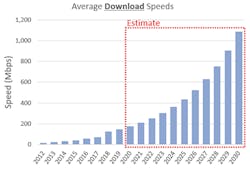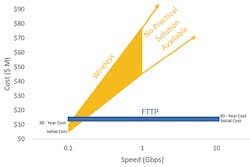Economic Comparison of 3 Rural Broadband Terrestrial Technologies
Coauthored By Larry D. Thompson, Brian P. Enga, and Brian Bell —
Only 20 years ago, it was hard to imagine why someone would need a broadband speed of even just 1 Mbps. Today, the national average broadband speed has increased by 150 times that.
As broadband speeds have rapidly and consistently increased over the last 20 years, many areas of our lives have come to depend upon the capabilities provided by such access. Over the course of the pandemic, the need for high-quality, fast, and reliable, broadband has become even more critical to our education, retail, healthcare, public safety, and entertainment — nearly every aspect of our lives. Given growth trends that continue apace, there does not seem to be a plateau in sight for the increasing broadband demands or broadband usage.
The average broadband speed in the US was 146.1 Mbps in October 2019, according to the Federal Communications Commission’s (FCC) Tenth Measuring Broadband America Report.1 This speed has increased by an average of 35% annually since the first report in 2012, and 54% annually since the FCC’s Eighth Report just 2 years ago.2 At this rate, the average broadband download speed will exceed 1 Gbps within the next 6 years.
The Cisco Annual Internet Report (2018-2023) White Paper3 shows a far more conservative 20% annual growth rate from 2018-2023. Using the average speed from 2012 to 2019 from the FCC’s MBA report but applying the more conservative 20% increase from the Cisco Annual Internet Report, the average speed will be 1 Gbps by 2030 (See Figure 1.)
Figure 1. Estimated Average Download Speeds (Source: Using the average speed from 2012 to 2019 from the FCC’s MBA report but applying the more conservative 20% increase from the Cisco Annual Internet Report.)
In addition, OpenVault estimates that the monthly weighted average data consumed by subscribers in 4Q20 was 482.6 GB, up 40% from 4Q19’s weighted average of 344 GB, and up nearly 26% quarter-over-quarter from 3Q20. Furthermore, 14.1% of weighted average subscribers use over 1 TB of data per month.4
With this as a backdrop, there are several alternative architectures to consider when implementing a broadband network today. Each of these alternatives has trade-offs when considering broadband speed, reliability, scalability, capital expense, operational expense, and speed of deployment. These factors, and others, determine the network’s total cost of ownership, which impacts not only the amount of end-user revenues that are needed but in some areas the amount of state or federal support required to sustain the network and services.
Our goal herein is to determine the most practical broadband network to deploy to areas currently lacking broadband — a greenfield build in unserved areas — that meets and keeps pace with customer broadband needs, and minimizes total cost of ownership over a reasonable time horizon. The broadband network technologies this article considers are shown in Figure 2.
Figure 2. Broadband Access Technologies
Cost and Performance Summary
It is important to analyze the costs associated with the 3 basic broadband architectures noted in Figure 2 — fixed wireless, HFC, and FTTP — for both initial investment and the expected 30-year investment.
To compare the costs of deploying broadband using these various technologies, we applied network layouts and cost estimates to a real area considered "typical" for a rural build. The area selected, in western Iowa and eastern South Dakota, reflects the kind of population density, difficulty of construction, and terrain, that Vantage Point sees in many rural deployments.
Since most of the cost associated with deployment of a landline network is the labor cost associated with placing the cable, it is unlikely that the provider would place any type of copper or HFC cable in a greenfield build given the substantially better broadband performance provided by a fiber cable that can be installed at a comparable price. Therefore, only wireless and FTTP networks were considered.
For this analysis it was assumed that outside plant cable would last at least 30 years, electronics would last 7 years, on average, and the subscriber base remains stable with a 70% subscriber penetration rate. In addition to estimating the 30-year cost, we also estimate the 30-year performance for each network.
Though no one can predict the future, industry history suggests that there will be far fewer technical barriers for increasing broadband speeds in the future on a wireline network (especially FTTP networks) than on a wireless network. The primary method to increase speeds on a wireless network is to obtain and use more spectrum. All of the remaining spectrum that could be used for broadband purposes, however, is currently being used by others and would need to be repurposed for broadband. The assumptions when estimating future performance can be seen in Figure 3.
Figure 3. Future Performance Assumptions
Figure 4 shows that 100/20 Mbps wireless broadband (using mid band spectrum) has a lower initial cost than does a FTTP network. However, these cost savings mostly disappear over time, since a much larger portion of a wireless network is comprised of electronics which must be replaced every 5-10 years, whereas the FTTP network is made up mostly of fiber optic cable which can last 30 or more years. In the long term, then, mid band wireless network costs are not significantly different than a FTTP network, but the mid band wireless network delivers far less capability. Referring back to Figure 1, the mid band wireless design provides only half of the average broadband speed experienced by customers today and will fall even farther behind in the coming years. Figure 4 estimates that the mid band wireless network in this design may achieve speeds of 600 Mbps at the end of 30 years, yet the average broadband speed in the United States could be 40 Gbps or more if customer demand continues to increase at the current rate.
Figure 4. Cost Summary: Initial and Over 30 Years
Figure 5 graphically shows the comparison of the various technologies analyzed in this article in terms of investment versus performance. Ideally, one would want the technology in the lower righthand corner of this diagram (low cost and high performance). As one can see, FTTP provides high performance at a reasonable cost and very small incremental cost over the life of the network. However, the cost to provide wireless broadband increases more rapidly over time and as the provider increases the speed of broadband provided to its customers.
Figure 5. 30-year cost of FTTP versus wireless technology.
Conclusion
Densely populated urban areas provide the economies of scale to allow a variety of broadband technologies — both wireless and wireline — to be economically deployed. In sparsely populated rural areas, however, the tradeoffs must be considered to ultimately determine the best possible balance between performance and the total cost of ownership over time.
Oftentimes, the low-cost solution from an initial CapEx perspective does not always reflect the best economic choice in the long-term — especially when it struggles to provide adequate broadband today — much less in the future. It is clear, for example, that HFC networks do not represent an efficient choice for either cost or performance when it comes to deployment of a wireline technology in a greenfield scenario.
InvisiLight® Solution for Deploying Fiber
April 2, 2022Go to Market Faster. Speed up Network Deployment
April 2, 2022Episode 10: Fiber Optic Closure Specs Explained…
April 1, 2022Food for Thought from Our 2022 ICT Visionaries
April 1, 2022Moreover, while some — but not all — fixed wireless deployments may require less initial investment than a FTTP deployment, the fixed wireless investment costs become several times greater than the cost of a fiber deployment when designed to provide gigabit speeds and considering the cost over a longer-term timeframe. The fixed wireless deployment will also have greater operational costs over a fiber deployment since each tower requires commercial power and additional spectrum costs which were not considered in this analysis.
This analysis of a greenfield network examination shows that fiber represents the most economical choice for the most capable fixed broadband service on a long-term basis
References and Notes
This article is adapted from the white paper Future Proof: Economics of Rural Broadband, Comparing Terrestrial Technologies & Investment Considerations to Meet Increasing Consumer Broadband Demands, A Greenfield Rural Broadband Case Study for FRS, May 2021. You can find the white paper at https://www.ntca.org/sites/default/files/documents/2021-05/Future%20Proof%20–%20Economics%20of%20Rural%20Broadband%20FINAL.pdf.
1. FCC’s Tenth Measuring Broadband America (MBA), Fixed Broadband Report, January 4, 2021.
2. Ibid, page 7.
3. Cisco Annual Internet Report (2018-2023) White Paper, Updated March 9, 2020. https://www.cisco.com/c/en/us/solutions/collateral/executive-perspectives/annual-internet-report/white-paper-c11-741490.html
4. OpenVault Broadband Insights Report (OVBI), 4Q20
About the Authors
Larry D. Thompson, PE, is CEO, Vantage Point Solutions. Larry is a licensed professional engineer and has designed satellite, wireless, and broadband, wireline networks for more than 30 years. Larry is currently the CEO of Vantage Point Solutions, which has over 400 employees and is a national provider of engineering and consulting services. Over the years, he has assisted many wireless and wireline companies successfully manage their technical, regulatory, and financial challenges.
Brian P. Enga, PE, is Senior Technology Leader at Vantage Point Solutions. A member of the telecommunications industry for more than 20 years, Brian is a licensed Professional Engineer in several states. His career includes the coordination of many multimillion-dollar broadband network deployments, including technical research, plans and specifications development, vendor evaluation, project management, and final inspection; and managing many loan and grant application submittals for the financing of broadband deployments for both federal and state programs.
Brian Bell, PE, is Senior Engineering Staff at Vantage Point Solutions. Working in the telecom industry since 1999, he is heavily involved in both unlicensed and licensed wireless, FITL, FTTH, standby power, and Central Office grounding. A licensed Professional Engineer, Brian is responsible for the RF design and evaluations for wireless networks across the suite of current technology standards.













